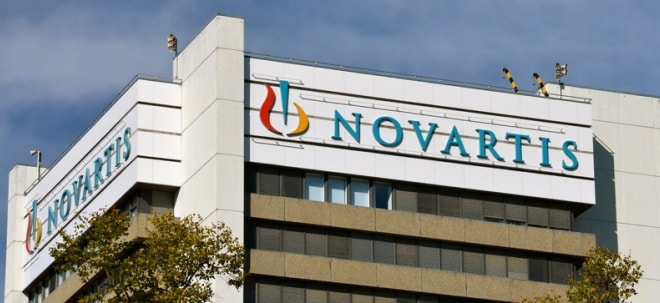Novartis Aktie 1200526 / CH0012005267
| Kurse + Charts + Realtime | News + Analysen | Fundamental | Unternehmen | zugeh. Wertpapiere | Aktion | |
|---|---|---|---|---|---|---|
| Kurs + Chart | Chart (gross) | News + Adhoc | Bilanz/GuV | Termine | Strukturierte Produkte | Portfolio |
| Times + Sales | Chartvergleich | Analysen | Schätzungen | Profil | Trading-Depot | Watchlist |
| Börsenplätze | Realtime Push | Kursziele | Dividende/GV | |||
| Orderbuch | Analysen | |||||
| Historisch | ||||||
|
17.10.2025 13:59:42
|
Press Release: Novartis Kisqali(R) 5-year NATALEE data demonstrate 28% reduction in risk of recurrence in the broadest early breast cancer patient population
-- After 5 years, Kisqali(R) plus endocrine therapy consistently shows
significant and clinically meaningful benefit in invasive disease-free
survival1
-- Kisqali remains the only CDK4/6 inhibitor demonstrating consistent and
clinically meaningful benefit across the broadest population of HR+/HER2-
early breast cancer (EBC) patients, including those with node-negative
disease1
-- Data also show a 29.1% risk reduction in distant disease-free survival,
and a positive trend in overall survival*1
-- With a median of around two years post-completion of treatment with
Kisqali, no new safety signals were observed1
Basel, October 17, 2025 -- Novartis today announced results from the five-year analysis of the pivotal Phase III NATALEE trial of Kisqali(R) (ribociclib) that demonstrated a sustained benefit at a median of two years after a three-year treatment with Kisqali (median follow-up: 58.4 months). Results showed a 28.4% reduction in risk of recurrence (HR=0.716; 95% CI 0.618-0.829; nominal p-value <0.0001) in the broadest population of patients with high-risk stage II and III hormone receptor-positive/human epidermal growth factor receptor 2-negative (HR+/HER2-) early breast cancer (EBC) treated with Kisqali plus endocrine therapy (ET) compared to ET alone(1).
The five-year invasive disease-free survival (iDFS) rates were 85.5% in the Kisqali plus ET arm versus 81.0% in the ET alone arm, representing a clinically meaningful 4.5% improvement(1). These late-breaking results will be presented at the European Society for Medical Oncology (ESMO) Congress 2025.
"For the thousands of people diagnosed with early breast cancer each year, the fear of recurrence, often as incurable advanced disease, weighs heavily on patients and their families," said Dr. John Crown, Consultant Medical Oncologist at St. Vincent's University Hospital, Dublin, and NATALEE investigator. "These five-year results show that the benefit of ribociclib persists well beyond the completion of treatment, offering these at-risk patients a greater chance of living breast cancer-free."
As follow-up continued, the confidence intervals (CIs) became narrower(1). This pattern held across clinically relevant subgroups, reinforcing the robustness of the observed iDFS benefit(1).
"These data reinforce the potential of Kisqali to significantly reduce the long-term risk of breast cancer recurrence, extending well beyond the three-year treatment period. This provides physicians and patients with greater confidence in long-term disease management. Kisqali is redefining the standard of care in adjuvant therapy, including in patients with node-negative disease," said Dushen Chetty, Global Head of Oncology and Hematology Development at Novartis, Ad Interim. "The consistency of the benefit observed across both advanced and early breast cancer settings, together with Kisqali's established safety profile, underscores its position as the CDK4/6 inhibitor with the most comprehensive Phase III evidence base for improving patient outcomes."
Overall survival (OS) continues to show an encouraging trend, with further improvement in the hazard ratio (HR) to 0.800 and narrowing CI (95% CI: 0.637-1.003; one-sided nominal p-value 0.026) compared to the final iDFS analysis (OS HR = 0.892 (0.661-1.203)), demonstrating a 20% reduction in the risk of death compared to ET alone(1). The NATALEE trial will continue follow-up to ensure sufficient data is collected for OS and other long-term endpoints.
iDFS results across pre-specified subgroups(1) :
Absolute risk
reduction at 5
Subgroups Hazard ratio 95% CI years
Overall population 0.716 0.618-0.829 4.5%
Stage II 0.660 0.493-0.884 3.7%
Stage III 0.730 0.615-0.865 5.6%
Node-negative (N0) 0.606 0.372-0.986 5.7%
Node-positive (N1-3) 0.737 0.631-0.860 4.4%
With a median of around two years after all patients completed Kisqali treatment, long-term safety shows no new safety signals(1). Overall, rates of secondary primary malignancies (SPMs) were 2.7% (Kisqali plus ET) and 3.0% (ET alone), while SPMs leading to deaths were reported in one patient in each group(1).
Kisqali remains the only CDK4/6 inhibitor to demonstrate statistically significant OS benefits across three randomized controlled trials in advanced breast cancer (MONALEESA-2, MONALEESA-3, and MONALEESA-7)(2-12).
*OS data remain immature at the five-year NATALEE analysis
About NATALEE
NATALEE is a global Phase III multi-center, randomized, open-label trial to evaluate the efficacy and safety of Kisqali with ET as an adjuvant treatment versus ET alone in the broadest range of patients with stage II and III HR+/HER2- EBC, being conducted in collaboration with TRIO(13,14). The adjuvant ET in both treatment arms was a non-steroidal aromatase inhibitor (NSAI; anastrozole or letrozole) and goserelin if applicable(13,14). The primary endpoint of NATALEE is invasive disease-free survival (iDFS) as defined by the Standardized Definitions for Efficacy End Points (STEEP) criteria(13,14). A total of 5,101 adult patients with HR+/HER2- EBC across 20 countries were randomized in the trial(13,14).
About Kisqali(R) (ribociclib)
Kisqali(R) (ribociclib) is a selective cyclin-dependent kinase inhibitor, helping slow the progression of cancer by inhibiting two proteins called cyclin-dependent kinase 4 and 6 (CDK4/6). These proteins, when over-activated, enable cancer cells to grow and divide quickly. Targeting CDK4/6 with enhanced precision plays a role in tumor control.
Kisqali has been approved as a treatment for breast cancer by regulatory authorities in more than 100 countries worldwide, including the U.S. FDA and the European Commission(15,16). In the US, Kisqali is indicated in combination with an AI as an adjuvant treatment for adults with HR+/HER2- stage II and III early breast cancer at high risk of recurrence, as well as for the treatment of adults with HR+/HER2- advanced or MBC as initial ET; Kisqali is also approved in the metastatic indication in combination with fulvestrant as initial ET or following disease progression on ET(15). In the EU, Kisqali is approved in combination with an AI for the adjuvant treatment of patients with HR+/HER2- early breast cancer at high risk of recurrence; and for the treatment of women with HR+/HER2- advanced or MBC in combination with either an AI or fulvestrant as initial ET or following disease progression(16). In pre- or peri-menopausal women, the ET should be combined with a luteinizing hormone-releasing hormone agonist(15,16).
In EBC, Kisqali is the only CDK4/6 inhibitor recommended by the NCCN Guidelines(R) for breast cancer as Category 1 preferred for both all node-positive disease as well as for patients with no nodal involvement with high-risk disease characteristics, such as tumor size >5 cm, or for tumors sized 2-5 cm, either Grade 2 with high genomic risk/Ki-67 >=20% or Grade 3(17). Kisqali approvals in EBC from regulatory authorities worldwide are ongoing, including recent approval from China's National Medical Products Administration(1) (8). In MBC, Kisqali has consistently demonstrated statistically significant overall survival benefit across three Phase III trials(2-12). The NCCN Guidelines(R) also recommend Kisqali as the only Category 1 preferred CDK4/6 inhibitor for first-line treatment of people living with HR+/HER2- MBC when combined with an AI, making Kisqali the preferred first-line treatment of choice for US prescribers in HR+/HER2- MBC(17).
In addition, Kisqali has achieved the highest score (A) on the European Society for Medical Oncology-Magnitude of Clinical Benefit Scale (ESMO-MCBS) for EBC(19) ; and has the highest rating of any CDK4/6 inhibitor on the ESMO Magnitude of Clinical Benefit Scale, achieving a score of four out of five for first-line pre-menopausal patients with HR+/HER2- advanced breast cancer(20). Further, Kisqali in combination with either letrozole or fulvestrant has uniquely, among other CDK4/6 inhibitors, received a score of four out of five for post-menopausal patients with HR+/HER2- advanced breast cancer treated in the first line(21).
Kisqali was developed by Novartis under a research collaboration with Astex Pharmaceuticals.
Please see full Prescribing Information for Kisqali, available at www.Kisqali.com
About Novartis in Breast Cancer
For more than 30 years, Novartis has been at the forefront of driving scientific advancements for people touched by breast cancer and improving clinical practice in collaboration with the global community. With one of the most comprehensive breast cancer portfolios and pipeline, Novartis leads the industry in discovery of new therapies and combinations in HR+/HER2- breast cancer, the most common form of the disease.
Disclaimer
This is a legal statement identifying forward-looking statements involving known and unknown risks and uncertainties. You should include the standard disclaimer in your release as outlined in the Global Press Release Approval Guidelines.
(MORE TO FOLLOW) Dow Jones Newswires
October 17, 2025 08:00 ET (12:00 GMT)
Nachrichten zu Novartis AG
|
17:58 |
Aufschläge in Europa: STOXX 50 steigt zum Ende des Dienstagshandels (finanzen.ch) | |
|
17:58 |
Aufschläge in Zürich: SLI bewegt sich zum Handelsende im Plus (finanzen.ch) | |
|
16:29 |
Novartis Aktie News: Novartis am Dienstagnachmittag höher (finanzen.ch) | |
|
15:58 |
Fehlende Impulse in Europa: STOXX 50 kaum bewegt (finanzen.ch) | |
|
15:58 |
Gewinne in Zürich: SLI klettert am Nachmittag (finanzen.ch) | |
|
12:29 |
Novartis Aktie News: Novartis gewinnt am Mittag an Boden (finanzen.ch) | |
|
09:29 |
Novartis Aktie News: Novartis fällt am Dienstagvormittag (finanzen.ch) | |
|
01.12.25 |
Handel in Zürich: SMI bewegt sich im Plus (finanzen.ch) |
Analysen zu Novartis AG
| 21.11.25 | Novartis Neutral | UBS AG | |
| 21.11.25 | Novartis Buy | Deutsche Bank AG | |
| 21.11.25 | Novartis Underweight | Barclays Capital | |
| 21.11.25 | Novartis Outperform | Bernstein Research | |
| 20.11.25 | Novartis Neutral | UBS AG |
3 Knaller-Aktien im BX Musterportfolio📈: Broadcom, Quanta Services & ING mit François Bloch
Im BX Morningcall werden folgende Aktien analysiert und erklärt
✅ Broadcom
✅ Quanta Services
✅ ING Group
👉🏽 https://bxplus.ch/bx-musterportfolio/
Inside Trading & Investment
Mini-Futures auf SMI
Inside Fonds
Meistgelesene Nachrichten
Top-Rankings
Börse aktuell - Live Ticker
SMI schliesst im Plus -- DAX zieht letztlich an -- Börsen in Fernost beenden Handel verhaltenDer heimische Aktienmarkt und der DAX fuhren am Dienstag moderate Gewinne ein. Unterdessen blieben die Anleger in Asien überwiegend in Deckung.





